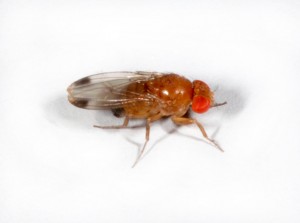When Fruit Flies Have a Refined Taste
Dillon Guynup
Drosophila suzukii. Wiki Commons
I’m sure we have all left fruit or veggies out of the fridge for too long. In addition to the brown spots on bananas, rotten strawberries, and mushy apples, small, black flies have started eating what we should have. As annoying as it is that we wasted those apples we just bought, at least the fruit flies started eating the fruit after it was already rotten. However, what if the fruit flies began eating the fruit while it was ripening in the sun in your home? Even worse, what if they started eating those strawberries while they were still ripening on the vine? The study by Keesey et. al (2015) investigated one of the new and upcoming fruit fly species, Drosophila suzukii, that does just that.
The Experiment
D. suzukii is a new pest in North America and Europe that occupies a specific niche within fruit flies. This is because it is attracted to the scents associated with ripening fruit unlike other species which are mainly attracted to rotting fruit. Cherries, raspberries, strawberries, and blueberries are its favorite snack. Since D. suzukii is an up and coming pest, not much is known about it in comparison to other fruit flies, such as D. melanogaster, everyone’s favorite model organism. This study compared how receptive 3 different species were to different scents associated with fruits at various levels of ripeness. They believed that various levels of receptivity to fruit scent caused D. suzukii preference for less ripe fruit. Receptiveness was measured by monitoring the neurons that were associated with scent and counting how many times they fired. They found that D. suzukii and D. biarmipes both responded less to scents associated with fermentation than D. melanogaster. Not only that, but D. suzukii also responded more to scents associated with ripening fruits.
In order to test multiple scents together, they analyzed odors from various stages of strawberry ripeness. They then recreated these complex scents and tested the reaction times and strengths of the 3 species. This was done by using gas chromatography/electroantennographic detection. Basically, this allows the researchers to know exactly which responses correspond to which chemicals in the mixture. Not only did our new pest respond to scents associated with ripening strawberries, it also responded to them earlier than the other species.
They then trapped flies with fruit of different stages and leaves as bait. D. suzukii and D. biarmipes were both caught more than D. melanogaster when baited with leaves but they were all caught in the highest numbers when overripe fruit was the bait. A chemical in leaves was only attractive to D. suzukii: β-cyclocitral.
D. suzukii eating a raspberry. Wiki Commons
So?
By finding this species specific bait, future research will be easier to conduct since it will ease capture of D. suzukii. Also, β-cyclocitral is mainly found in leaves but the pest eats and lays its eggs in the fruit. This is the first case of a chemical cue indirectly triggering feeding and oviposition behavior in fruit flies. That disproves their hypotheis since the scent was not directly associated with the fruit itself but of the leaves around it.
I’m sure you’re asking yourself why any of this matters. Well, now that we know that the fruit fly is attracted to ripening fruit because of the chemicals released from their leaves, it is possible to protect our fruit crops. Since β-cyclocitral is released in higher quantities from damaged leaves, it is plausible that by protecting the leaves from physical stress, D. suzukii will have a harder time finding the fruit. Also, if there is some chemical that blocks β-cyclocitral from being received by the fruit fly, then they might not have a niche for feeding on ripening fruit. More research has to be done but this study both makes future research easier and hints at why D. suzukii is such a problem due to its refined palate.
References
Keesey, I. et al. (2015). Olfactory specialization in Drosophila suzukii supports an ecological shift in host preference from rotten to fresh fruit. Journal of Chemical Ecology, 41(2), 121-128.


